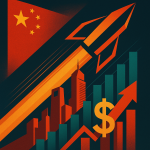Key Points
- The Chinese private fund industry is undergoing a significant consolidation, characterized by the “Matthew effect” where AUM continues to rise (¥20.27 trillion RMB by May 2025) while the number of fund managers and funds shrinks.
- For the first time, voluntary liquidations (328 funds) outnumbered association-initiated (forced) liquidations (264 funds) in H1 2025, driven by soaring compliance costs and a lack of professional edge among smaller players.
- New PFM registrations have seen a sharp decline, with only 72 new PFMs approved in H1 2025, significantly down from 619 in H1 2022, indicating much stricter entry criteria.
- New fund product filings also decreased dramatically, with 7,579 products filed in H1 2025, compared to over 15,000 in H1 2023 and 2022, reflecting cautious capital deployment.
- Regulatory oversight remains strict, with 225 penalties issued in H1 2025 to 61 private funds and 164 individuals, surpassing full-year totals for 2021 and 2022, underscoring the “shape up or ship out” message.

An unprecedented shake-up is hitting China’s private fund industry in H1 2025, and it’s not what you think.
As regulators continue to tighten the screws, a fascinating new trend is emerging: more fund managers are voluntarily closing shop than are being forced out.
This “great resignation” of smaller funds is happening even as the total assets under management (AUM) in the industry continue to climb.
It’s a paradox that signals a massive consolidation and a flight to quality, forcing the entire sector to professionalize at a breakneck speed.
The Great Consolidation: A Tale of Two Trends
The Chinese private fund market is a textbook case of the “Matthew effect”—where the rich get richer, and the smaller players get squeezed out.
Here’s the deal:
The total AUM for existing private funds hit a staggering ¥20.27 trillion RMB ($2.80 trillion USD) by the end of May 2025, showing a steady month-on-month increase this year.
But at the same time, the number of active private fund managers and the total number of funds are both shrinking every month.
This growing gap is creating a brutal environment for mid-to-small private funds, leaving them with a stark choice: scale up or shut down.

Resume Captain
Your AI Career Toolkit:
- AI Resume Optimization
- Custom Cover Letters
- LinkedIn Profile Boost
- Interview Question Prep
- Salary Negotiation Agent

The New Kids on the Block: Who’s Getting In?
While many are leaving, a select few are still getting in. In the first half of 2025, the Asset Management Association of China (AMAC) approved 72 new private fund managers (PFMs).
That’s slightly up from 66 in H1 2024, but way down from the gold rush days of 2022 and 2023.
The newcomers are not your average fund managers. They are increasingly specialized, with two clear defining traits:
- A focus on quantitative investment strategies.
- Deep experience from public fund backgrounds.
Let’s look at the talent pipeline:
- Zhang Zifa (张子法), VP of Wuhan Beige (Wuhan Beige 武汉北格), is a former financial engineer from China Universal Asset Management (Huaxia Jijin 华夏基金) and a quantitative expert from Tianhong Asset Management (Tianhong Jijin 天弘基金).
- Yu Hao (余浩), the man behind Shenzhen Jiumucheng (Shenzhen Jiumucheng 深圳九木成), is a quant veteran from Southwest Securities (Xinan Zhengquan 西南证券) and helped build the quant private fund Zhongliang Investment (Zhongliang Touzi 中量投资产).
- Wang Jian (王健) of Shanghai Shiying (Shanghai Shiying 上海世赢) has a resume that includes stints at Changxin Fund (Changxin Jijin 长信基金) and Chang’an Fund (Chang’an Jijin 长安基金).
- Xiong Wei (熊伟), GM of Jiangsu Boyi (Jiangsu Boyi 江苏博益), spent years at the powerhouse Bosera Asset Management (Boshi Jijin 博时基金).
Even insurance giants are getting in on the action, with two new insurance-backed private funds, Taikang Wenxing (Taikang Wenxing 泰康稳行) and Taibao Zhiyuan (Taibao Zhiyuan 太保致远), getting registered.

The Data Dive: Registrations and Filings by the Numbers
To understand the scale of this slowdown, let’s break down the data from the AMAC.
New PFM Registrations: A Clear Downtrend
While 72 new PFMs were registered in H1 2025, this pales in comparison to previous years.
- H1 2025: 72 new PFMs
- H1 2024: 66 new PFMs
- H1 2023: 326 new PFMs
- H1 2022: 619 new PFMs
The monthly breakdown for H1 2025 shows just how selective the process has become:
- January: 13
- February: 6
- March: 19
- April: 16
- May: 4
- June: 14
New Product Filings: Capital is Getting Cautious
It’s not just new managers; the number of new fund products being launched is also way down.
In the first half of 2025, a total of 7,579 private fund products were filed.
Compare that to previous years:
- H1 2024: 5,612 products
- H1 2023: 15,020 products
- H1 2022: 15,262 products
Total capital raised for these new products in the first five months of 2025 was ¥266.213 billion RMB ($36.76 billion USD), highlighting a more cautious deployment of capital compared to the frenzy of past years.

Find Top Talent on China's Leading Networks
- Post Across China's Job Sites from $299 / role, or
- Hire Our Recruiting Pros from $799 / role
- Qualified Candidate Bundles
- Lower Hiring Costs by 80%+
- Expert Team Since 2014
Your First Job Post

The Big Shift: Why “Voluntary Exits” Now Trump “Forced Removals”
This is the most crucial takeaway from H1 2025.
In the first half of the year, 604 private funds were liquidated. But the way they were liquidated tells the real story.
- Voluntary Liquidations: 328 funds
- Association-Initiated Liquidations (Forced): 264 funds
- Inactive for 12 months: 43 funds
- Public Announcement: 1 fund
For the first time in recent years, more funds chose to exit on their own terms than were kicked out.
This is a dramatic reversal from 2024 and 2023, when association-initiated “forced removals” were the dominant form of liquidation.
Why the change?
Industry insiders point to two key factors:
- Soaring Compliance Costs: Stricter regulations mean higher operational overhead. For smaller funds, the cost of staying compliant is becoming too high.
- Lack of Professional Edge: In a consolidating market, funds without sufficient professional capabilities or a unique edge are finding it impossible to compete and attract capital.
This shift from “passive elimination” to “voluntary exit” is a strong sign that the industry is self-correcting and optimizing for higher standards.

ExpatInvest China
Grow Your RMB in China:
- Invest Your RMB Locally
- Buy & Sell Online in CN¥
- No Lock-In Periods
- English Service & Data
- Start with Only ¥1,000

The Watchdog’s Bite: No Letting Up on Penalties
Just because funds are leaving voluntarily doesn’t mean the regulators are taking a break.
The AMAC has maintained its strict oversight. In the first half of 2025 alone, it issued 225 penalties involving 61 private funds and 164 individuals.
While the number of penalties is down slightly from H1 2024, it has already surpassed the total for the same period in 2023 and the full-year totals for both 2022 and 2021.
The message from Beijing is crystal clear: shape up or ship out.
- H1 2025: 225 Penalties (61 Private Funds, 164 Individuals)
- Full Year 2023: Less than H1 2025
- Full Year 2022: Less than H1 2025
- Full Year 2021: Less than H1 2025
Key Takeaways for Investors and Founders
What’s the bottom line?
- Consolidation is King: The market is concentrating around larger, more established players. The “Matthew effect” is in full swing.
- Specialization is the New Standard: New entrants are highly specialized, typically with deep quant or public fund expertise.
- Professionalism is Non-Negotiable: High compliance costs and intense competition are weeding out weaker funds, leading to a healthier, more professional market.
- Regulation is a Constant: Strict oversight is here to stay, forcing a higher standard of operations across the board.
The era of easy money and explosive growth in China’s private fund industry is over. What’s emerging is a more mature, optimized, and professional landscape, which could present a far more stable and compelling opportunity for serious, long-term investors looking at China’s private fund industry.





